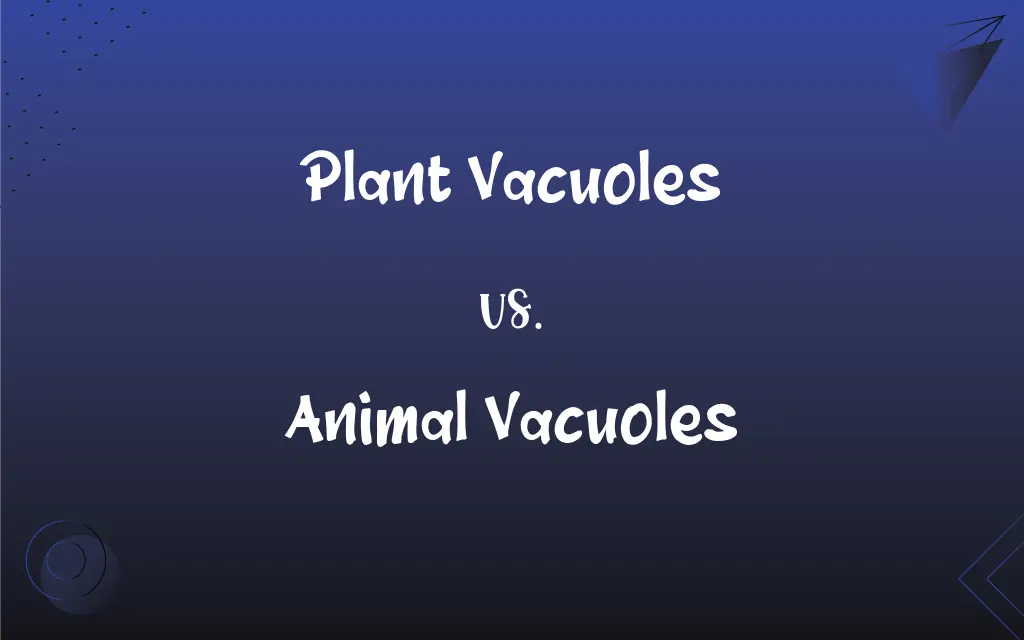Plant Vacuoles vs. Animal Vacuoles: What's the Difference?
Edited by Aimie Carlson || By Harlon Moss || Updated on October 28, 2023
Plant vacuoles are large, central sacs storing water, waste, and nutrients, while animal vacuoles are smaller, transient structures for waste and transport.

Key Differences
Plant vacuoles are primarily large central structures in most mature plant cells. They serve as storage units for water, nutrients, and waste products. On the other hand, animal vacuoles are generally smaller and more numerous in animal cells.
In plant cells, the vacuole has a vital role in maintaining turgor pressure, which helps the plant maintain its rigidity. Animal vacuoles, however, don't play a significant role in cellular rigidity but are more involved in the sequestration and transport of substances.
The membrane surrounding plant vacuoles is called the tonoplast. This membrane is selectively permeable, helping maintain internal cell pH and ion concentrations. Animal vacuoles have a membrane as well, but its composition and function can differ based on the type of vacuole.
Plant vacuoles can occupy up to 90% of a cell's volume in mature cells, giving them a distinct appearance. Animal vacuoles, being smaller and more diverse in function, don't dominate the cell's interior space in the same way.
One major distinction between plant and animal vacuoles is their content. Plant vacuoles often contain a solution called cell sap, comprising water, sugars, ions, and other solutes. Animal vacuoles typically contain water, ions, and waste products, depending on their specific function in the cell.
ADVERTISEMENT
Comparison Chart
Size and Number
Large, central, and singular in mature cells
Smaller and multiple in cells
Function
Storage of water, nutrients, and waste; maintain turgor pressure
Sequestration, transport, and waste removal
Membrane Name
Tonoplast
No specific name; varies based on function
Content
Cell sap (water, sugars, ions)
Water, ions, and waste products
Significance in Cell
Can occupy up to 90% of a cell's volume in mature cells
Don't dominate cell's interior; more diverse in function
ADVERTISEMENT
Plant Vacuoles and Animal Vacuoles Definitions
Plant Vacuoles
Plant vacuoles often contain a solution known as cell sap.
The plant vacuole's cell sap provides the cell with essential nutrients.
Animal Vacuoles
Animal vacuoles don't have a standard membrane name like plant vacuoles.
Unlike the tonoplast in plant vacuoles, animal vacuoles have varied membranes.
Plant Vacuoles
Plant vacuoles are large membrane-bound compartments in plant cells.
The plant vacuole stores essential nutrients and waste products.
Animal Vacuoles
Animal vacuoles play roles in sequestration and transportation.
Animal vacuoles can isolate harmful substances and move them to safe areas.
Plant Vacuoles
In plant cells, vacuoles maintain turgor pressure.
When the plant vacuole loses water, the plant wilts.
Animal Vacuoles
Animal vacuoles vary in function and structure.
Not all animal vacuoles serve the same purpose in the cell.
Plant Vacuoles
The tonoplast is the specific membrane surrounding plant vacuoles.
The plant vacuole's tonoplast regulates what enters and exits the compartment.
Animal Vacuoles
Animal vacuoles are small membrane-bound structures in animal cells.
Animal vacuoles assist in the transport of substances within the cell.
Plant Vacuoles
Plant vacuoles play a role in regulating cell pH and ion concentrations.
By controlling its internal environment, the plant vacuole ensures cell health.
Animal Vacuoles
These vacuoles are involved in waste removal in animal cells.
Animal vacuoles contain waste products ready for expulsion from the cell.
FAQs
What's the main function of plant vacuoles?
Plant vacuoles store water, nutrients, and waste and maintain turgor pressure.
Do animal vacuoles have the same function as plant vacuoles?
No, animal vacuoles are more involved in the sequestration, transport, and waste removal.
Are animal vacuoles involved in cellular rigidity?
No, animal vacuoles don't play a significant role in cellular rigidity.
What do plant vacuoles store?
They store cell sap, including water, sugars, and ions.
Do animal vacuoles have a specific membrane name?
No, the membrane name varies based on the function of the animal vacuole.
How do plant vacuoles affect plant rigidity?
They maintain turgor pressure, helping the plant stay rigid.
Do animal vacuoles play a role in osmoregulation?
Not as prominently as plant vacuoles, but they do help in ion and waste balance.
Are plant vacuoles found in all plant cells?
Most mature plant cells have a large central vacuole.
Do animal vacuoles help animals respond to environmental stress?
While not their primary function, animal vacuoles can sequester harmful substances.
Do animal vacuoles dominate the cell's interior like plant vacuoles?
No, animal vacuoles are smaller and don't dominate the cell's space.
How do plant vacuoles help in osmoregulation?
By storing and releasing water, they help maintain internal cellular conditions.
Can animal vacuoles contain enzymes?
Yes, some animal vacuoles, like lysosomes, contain digestive enzymes.
What's the membrane of plant vacuoles called?
It's called the tonoplast.
How common are animal vacuoles in animal cells?
Animal cells typically have multiple smaller vacuoles with diverse functions.
Are there different types of animal vacuoles?
Yes, animal vacuoles can vary in structure and function based on their role in the cell.
Is the content of plant vacuoles always the same?
No, the content can vary based on the cell's needs and environmental conditions.
How do plant vacuoles and animal vacuoles differ in appearance?
Plant vacuoles are larger, central structures, while animal vacuoles are smaller and more numerous.
What's typically found in animal vacuoles?
They usually contain water, ions, and waste products.
Can plant vacuoles aid in a plant's response to environmental stress?
Yes, they can adjust their content to help the plant adapt to environmental changes.
Can plant vacuoles occupy a significant portion of a cell's volume?
Yes, they can occupy up to 90% of a mature cell's volume.
About Author
Written by
Harlon MossHarlon is a seasoned quality moderator and accomplished content writer for Difference Wiki. An alumnus of the prestigious University of California, he earned his degree in Computer Science. Leveraging his academic background, Harlon brings a meticulous and informed perspective to his work, ensuring content accuracy and excellence.
Edited by
Aimie CarlsonAimie Carlson, holding a master's degree in English literature, is a fervent English language enthusiast. She lends her writing talents to Difference Wiki, a prominent website that specializes in comparisons, offering readers insightful analyses that both captivate and inform.































































